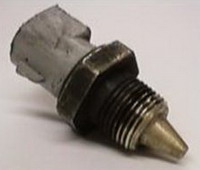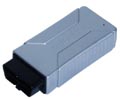- Coolant Temp Sensor
- |
- Engine Sensors
- |
- Fuel Injection
- |
- Repair Basics
- |
- Technical Info
- |
- Car Tech Info
- |
- MicroTronik
Coolant Temperature Sensor

Coolant Temperature Sensor
This sensor normally has a Negative Temperature Coefficient (NTC), which means that the resistance of the component reduces as the temperature increases.
A Positive Temperature Coefficient (PTC) sensor is not as common as the NTC and its resistance reacts to temperature in the opposite way.
To increase the drivability of the vehicle and performance on pre 1992 non-cat cars, the resistance can be altered by calculating and inserting a resistor in series with the coolant temperature sensor, however, this resistance has to be calculated before its insertion. The resistor should not be inserted in series when the CTS is an NTC device. It should also be noted that the resistor should not be placed in parallel, as this will reduce the overall resistance. This modification cannot, however, be implemented on engines equipped with a catalytic converter as this extra fuelling will upset the corrective nature of the lambda or oxygen sensor.
The sensors are manufacturer-specific and the outputs vary dramatically although the sensors may look identical. Any poor connections on this circuit will introduce an extra resistance in series and will falsify the readings that the ECM sees - reading the resistance at the ECM multi-plug will confirm this.
The Coolant Temperature Sensor (CTS) is invariably be a two-wire device with a voltage supply of approximately 5 volts.
The sensor itself has the ability to alter its resistance with engine temperature change. The majority of sensors have a Negative Temperature Coefficient (NTC), which results in the resistance of the component decreasing as the temperature increases. The resistance change therefore alters the voltage seen at the sensor and can be monitored for any discrepancies across its operational range.
Select a time scale of 500 seconds, then connect the oscilloscope to the sensor and observe the output voltage.
Start the engine and in the majority of cases the voltage will start in the region of 3 to 4 volts, but will depend on the temperature of the engine; as the temperature increases the resistance decreases and the voltage will also be seen to drop.
The rate of voltage change is usually linear with no sudden changes to the voltage. If the CTS displays a fault at a certain temperature, this is the only true way of detecting it.
AutoHex (Auto Diagnostic scanner) is one of the best Professional scan tools to for Cars; Autohex Scanner can test the Systems of the Car effectively and easily, with many powerful features to help you in diagnosing and testing.
Changing Dmaged DME in F Series
Description
The following section give some details about Coolant Temperature Sensor input to the ECM of the vehicle that contribute towards the desired injector duration
Autohex II Reviews
AutoHex II
AutoHex II is your best choice to have full access to dealer functions like coding, adjusting and modules flashing/programming, Contact us for prices
AutoHex Forum


